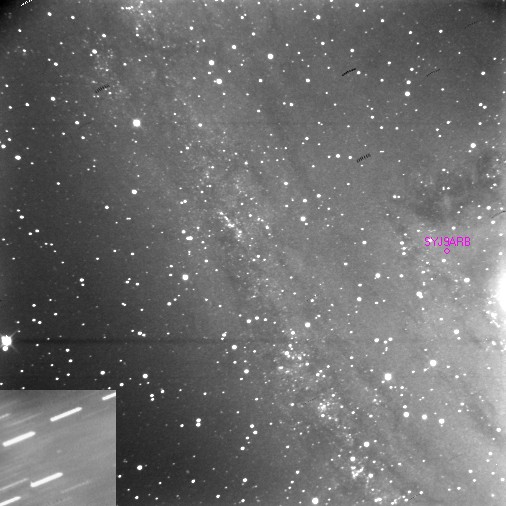Image of the Month - November 2002
Faint Asteroid in a distant Galaxy
On October 13, 2002, the NEAT asteroid survey
discovered an apparently unusual asteroid
using the 1.2m Oschin Schmidt
Telescope at the Palomar Mountain Observatory.
The object, then only known by it's temporary designation SYJ9ARB, was confimed less than 20 hours
later by Kyle Smalley and Mitch Glaze at Powell Observatory. They found the asteroid sailing trough
the Great Andromeda Galaxy, Messier 31.
Of course, the proximity is only an illusion: While the asteroid was only about seven light minutes
away when the image was taken, the galaxy is a
world of it's own, in about 2.5 million light years distance.
These and some additional observations published on MPEC 2002-U03,
confirmed that SYJ9ARB, which is now designated as 2002 TS190, has a unusual Mars-approaching orbit, which is nearly
circular, but highly inclined (47°) to the ecliptic.

Credit & Copyright: Kyle Smalley,
Powell Observatory, Louisburg, Kansas, U.S.A.
Asteroid 2002 TS190, imaged on October 14, 2002, by Kyle Smalley and Mitch Glaze,
Powell Observatory, Louisburg, Kansas, U.S.A.
Fifteen images, each a 45 second exposure, taken with a Apogee AP-8 CCD (funded by NASA OSS Grant)
on a 0.75m Newtonian reflector, were stacked with Astrometrica for this view. (Click on
the image to see the full resolution one megapixel image.) While the asteroid, shining at only
20mag, is hardly visible in this image, stacking the same images and compenasting
for the asteroids motion of 2"/minute brings out the faint interloper, as shown in the inset.
Related Links:
2002 TS190 Orbit Animation (JPL)
SEDS Messier database
Image of the Month
Previous | Archive | Next
[ Home |
Downloads |
Version History |
Star Catalogs |
Registration |
Mailing List |
About the Author |
Minor Planets |
Monthly Image |
Papers |
Links ]
